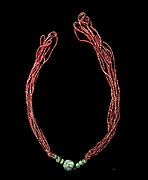Kanak people
The Kanaks (French spelling until 1984: Canaque) are the indigenous Melanesian inhabitants of New Caledonia, an overseas collectivity of France in the southwest Pacific. Kanak peoples traditionally speak diverse Austronesian languages that belong to the New Caledonian branch of Oceanic. According to the 2019 census,[1] the Kanaks make up 41.2% of New Caledonia's total population — corresponding to around 112,000 people. The other populations are the Caldoche, who are European born in New Caledonia; the Zoreille, who were born in metropolitan France and live in New Caledonia, in addition to about 10% that are non-Kanak Polynesians and 10% that are mixed race.
"Kanak" redirects here. For other uses, see Kanak (disambiguation).Total population
111,856[1]
A few thousand
The earliest traces of human settlement in New Caledonia go back to Lapita culture, about 3000 BP, i.e. 1000 BCE.[2][3] In addition, Polynesian seafarers have intermarried with the Kanaks over the last centuries.[4][5] New Caledonia was annexed to France in 1853, and became an overseas territory of France in 1956. An independence movement, which led to a failed revolt in 1967, was restarted in 1984, pursuing total independence from French rule. When the 1988 Matignon agreements were signed between the representatives of France and New Caledonia to decide on holding the referendum for independence, Jean-Marie Tjibaou, the Kanak leader of the independence movement, had mooted a proposal to set up an Agency for the Development of Kanak Culture (ADCK). After Tjibaou's assassination in 1989, the French President François Mitterrand ordered that a cultural centre on the lines suggested by Tjibaou be set up in Nouméa, the capital of New Caledonia; it was to be the last of Mitterrand's Grands Projets.[6] The Jean-Marie Tjibaou Cultural Centre was formally established in May 1998.[7]
Although ancient Lapita potteries date back to 1000 BC, and the people of the island have long been involved in the arts, since the establishment of the ADCK, Kanak arts and crafts have become more popular in New Caledonia. Wooden carvings in the shape of hawks, ancient gods, serpents and turtles are popular as is flèche faîtière, a carving which resembles a small totem pole with symbolic shapes. Music, dance and singing are part of many a Kanak ceremonial function and dances are performed during the traditional Kanak gatherings with the objective of cementing relationships within the clan and with ancestors.
The word Kanak (originally spelled Canaque in French) is derived from kanaka maoli, a Hawaiian phrase meaning 'ordinary person' which was at one time applied indiscriminately by European colonisers, traders and missionaries in Oceania to any non-European Pacific islander.[8] Kanaka in Hawaiian descends from the Proto-Polynesian root *taŋata meaning 'person',[9] a root which is not used in New Caledonian languages.[10] Prior to European contact, there were no unified states in New Caledonia, and no single self-appellation used to refer to its inhabitants.
In 1984, Melanesian leaders adopted the modern spelling Kanak as a preferred alternative to the old spelling Canaque, which was associated with the colonial period. The new form "kanak" does not inflect grammatically in French: e.g. the plural is “les Kanak” (*les Kanaks is incorrect); “les traditions kanak”, etc.
Other words have been coined from Kanak in the past few generations:
In German, the racial epithet Kanake — which is now applied to all non-whites, even southern Europeans in some cases, and especially to Turkish immigrants – also derives from the same source. It was originally applied to people from German colonial possessions in Oceania.[12]





